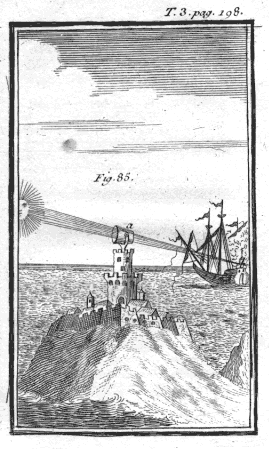Diocles
Today, we focus the rays of the sun. The University of Houston's College of Engineering presents this series about the machines that make our civilization run, and the people whose ingenuity created them.
Who was Diocles? We don't really know. All we have is a text he wrote over 2000 years ago. It's not even in his own tongue. It was written in AD 1462 by a careless scribe who left only spaces where figures should've gone. But it's enough to tell us that it was Diocles who invented the parabolic mirror.
Who was Diocles? Historian G.J. Toomer picks through this skimpy legacy -- this ancient text, titled On Burning Mirrors. Most of what we knew of Diocles came from reference to his work by a noted 6th-century mathematician. Now we finally read this copy of his book, penned 1600 years after the fact.
Toomer does his historical detective work. He decides that Diocles flourished in Greece just after 200 BC. He was a mathematician -- a geometer. Toomer takes us through the text, recreating the figures. We read Diocles' opening:
The burning-mirror surface submitted to you is the surface bounding the figure produced by a section of a ... cone ... revolved about [its axis].
That, of course, is the shape of a paraboloid, and paraboloids touch our modern world in the technology of solar towers:
A solar tower holds a steam-generating boiler high above a surrounding field of mirrors shaped into a gigantic parabola -- one great burning mirror. This mirror gathers in the energy of the sun and focuses it on the steam generator. It in turn drives a turbine. Diocles's mirror is the heart of a power system that we're still developing.
Diocles began with work Archimedes did a century before him. Although Diocles makes no such claim, you and I have heard the legend that Archimedes used burning mirrors to set the Roman fleet afire as it invaded Syracuse. The problem is, that that would've taken a technology beyond even the solar tower. Archimedes had studied far more primitive burning mirrors. He didn't yet have Diocles's efficient parabolic collector.
Before he plunges into the complex geometrical analysis, Diocles pauses to tell us the practical value of his theory. He tells how mathematicians have computed the enormous size of the solar system. He tells how we might use burning mirrors in temples for cremations -- how his optics might improve sundial design. Only then does he write down the same arithmetic I studied as an engineering student.
But I still want to know who Diocles was -- this man bent by the distant lens of history -- this almost forgotten Greek whose mathematical burning glass illuminated scholars in Baghdad and Renaissance Italy. Who was this ancient man who first designed the solar collectors that will yet warm our hearths -- in the 3rd millennium AD?
I'm John Lienhard, at the University of Houston, where we're interested in the way inventive minds work.
(Theme music)
Toomer, G.J., Diocles on Burning Mirrors. New York: Springer Verlag, 1976.
For more on Archimedes's burning mirror death ray, see Episode 252.

Artist's impression of a large burning mirror from Les Entretiens Physiques d'Arste et d'Eudoxe, 1745